Planning your mobile photo stories in advance is essential for creating compelling visual narratives. You'll define your narrative arc, identify key storytelling moments, and scout locations to anticipate lighting conditions. By preparing props and subjects beforehand, you'll craft a cohesive visual style that enhances your story's impact. You can anticipate potential challenges and organize your equipment efficiently, ensuring you're ready for any situation. Establishing a shot list helps you prioritize scenes and maintain a clear focus throughout your shoot. With careful planning, you'll be well-equipped to capture stunning images that effectively convey your message and captivate your audience. Discover how advance preparation can elevate your mobile photography to new heights.
Defining Your Narrative Arc
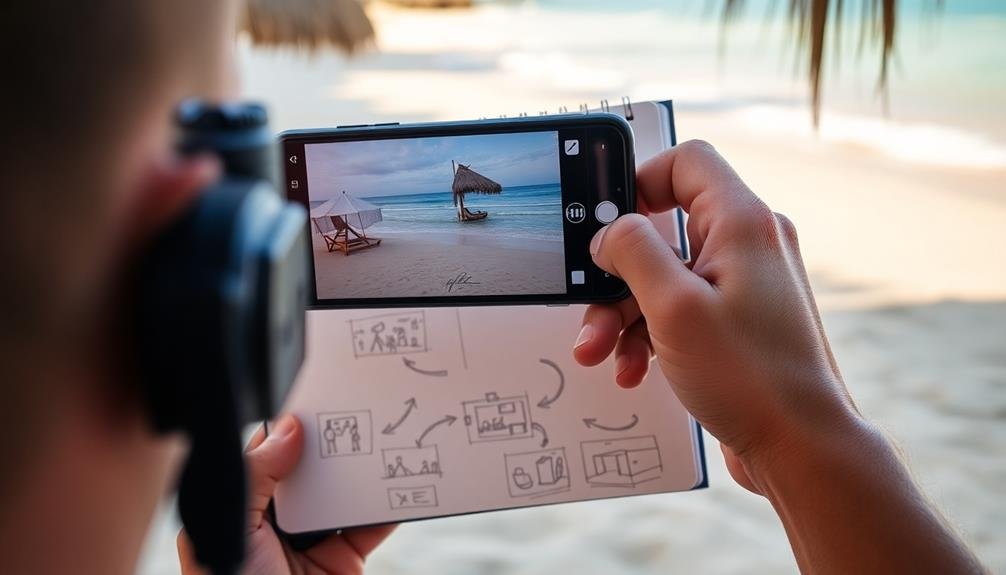
Crafting a compelling narrative arc is essential for your mobile photo story. Begin by identifying the central theme or message you want to convey. This will serve as the backbone of your narrative, guiding your photo selections and sequencing decisions. Consider the emotions you want to evoke and the journey you'll take your viewers on.
Next, outline the key elements of your story: the introduction, rising action, climax, falling action, and resolution. Each of these components should be represented visually in your photo sequence. Your opening shots should set the scene and introduce the main subject or conflict.
As you progress, build tension and interest through carefully chosen images that advance the narrative. The climax of your story should feature your most impactful or dramatic photos. Follow this with images that show the aftermath or consequences of the main event.
Identifying Key Storytelling Moments
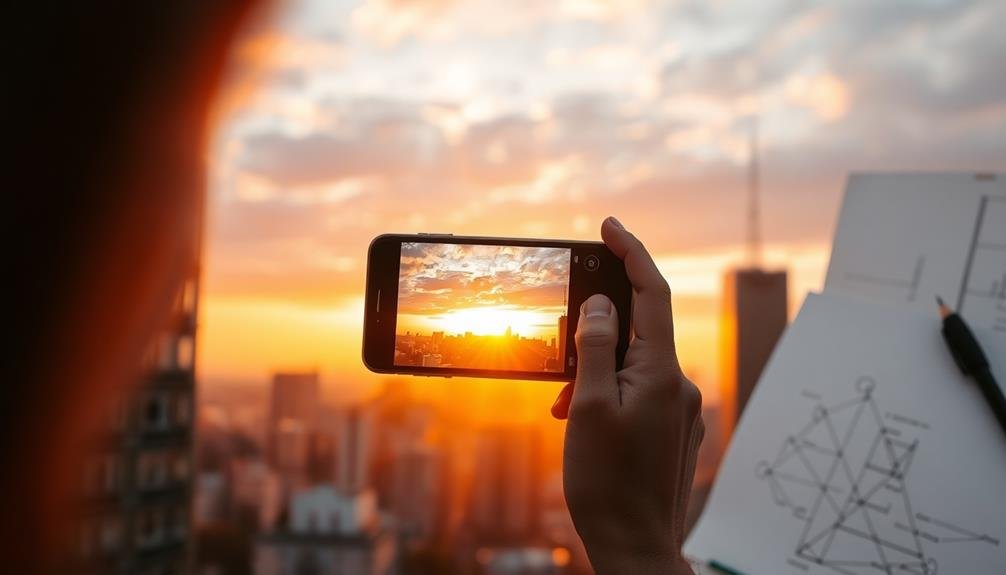
With your narrative arc in mind, it's time to pinpoint the essential moments that will drive your mobile photo story forward. These key storytelling moments are the building blocks of your narrative, capturing pivotal events, emotions, or shifts that engage your audience and propel the story.
To identify these vital moments, consider the following:
| Element | Description | Importance |
|---|---|---|
| Conflict | Central challenge or obstacle | Creates tension and interest |
| Turning Points | Significant shifts in the story | Mark critical developments |
| Climax | Peak of tension or action | Provides resolution or revelation |
As you plan, visualize each moment and how it contributes to your overall narrative. Think about the emotions you want to evoke and the information you need to convey. Remember, not every detail needs to be captured – focus on the moments that truly matter.
Consider the visual potential of each key moment. How can you frame it to maximize impact? What elements in the environment can enhance your storytelling? By identifying these vital points in advance, you'll be better prepared to capture them effectively when the time comes, ensuring a cohesive and compelling mobile photo story.
Scouting Locations in Advance
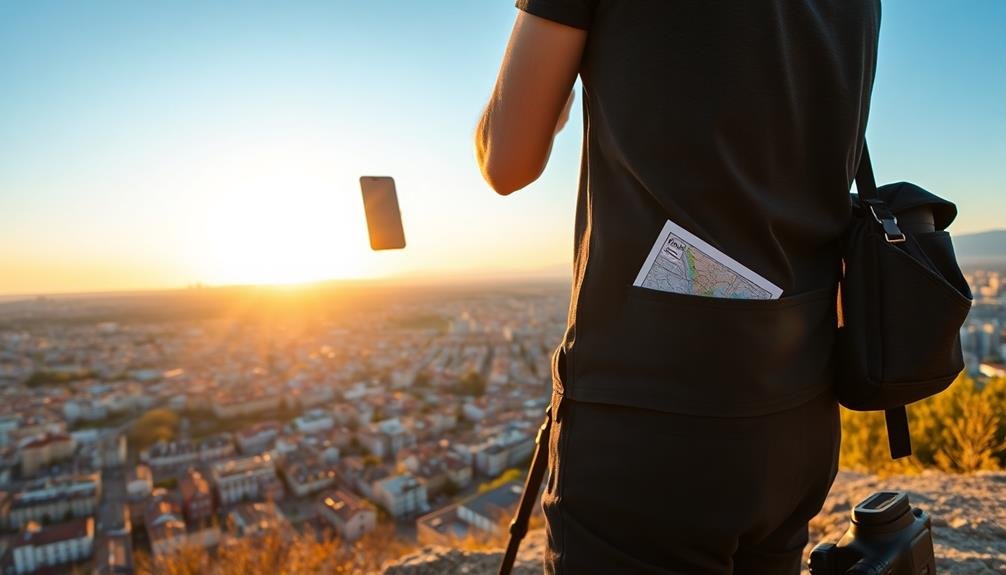
When you're scouting locations for your mobile photo story, consider the ideal lighting conditions for each spot.
You'll want to assess how sunlight interacts with your chosen environments at different times of day.
This advance preparation allows you to pre-plan compositions, ensuring you're ready to capture the perfect shots when you return with your mobile device.
Ideal Lighting Conditions
Scouting locations ahead of time for ideal lighting conditions is essential to capturing stunning mobile photo stories. When you're planning your shoot, consider the direction of sunlight throughout the day and how it'll affect your scenes.
Morning and evening golden hours offer warm, soft light that's perfect for portraits and landscapes. Midday sun can be harsh, but it's great for creating high-contrast urban shots or capturing vibrant colors.
You'll want to observe how light interacts with your chosen locations. Look for interesting shadows, reflections, or light patterns that can add depth to your images.
Don't forget to check the weather forecast, as overcast days can provide diffused light ideal for evenly lit shots. If you're shooting indoors, note the position of windows and artificial light sources to plan your compositions.
Consider using apps that track the sun's position and golden hour times to optimize your shooting schedule. By understanding the lighting conditions in advance, you'll be better prepared to adjust your camera settings and composition on the day of your shoot, ensuring you capture the best possible images for your mobile photo story.
Composition Pre-Planning Opportunities
Pre-planning your composition goes hand in hand with scouting locations for ideal lighting. When you visit potential shooting spots in advance, you'll have the opportunity to envision and plan your shots more effectively.
Take note of interesting architectural elements, natural landscapes, or unique features that could serve as focal points or framing devices in your photos. Reflect on how different angles and perspectives might enhance your storytelling.
Look for leading lines, patterns, or symmetry that could add visual interest to your compositions. By exploring the location beforehand, you can identify potential obstacles or distractions and plan ways to work around them.
Use this time to experiment with various compositions without the pressure of capturing the perfect shot immediately. Try out different framing options, test the rule of thirds, or explore unconventional viewpoints.
This practice will help you develop a mental catalog of composition ideas for when you return to shoot. Don't forget to reflect on how the location might change throughout the day or in different weather conditions.
This foresight will allow you to adapt your composition plans accordingly and maximize your shooting opportunities when you return with your mobile device.
Anticipating Lighting Conditions
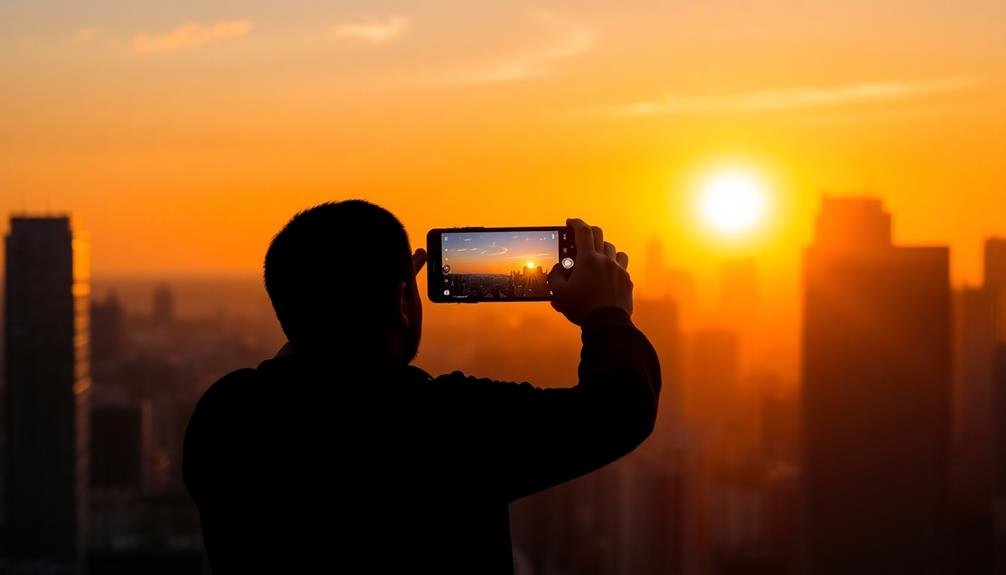
Three key factors influence lighting conditions for mobile photo stories: time of day, weather, and location. By anticipating these elements, you'll be better prepared to capture stunning images for your narrative.
Time of day affects the quality and direction of light. Golden hour, just after sunrise or before sunset, offers warm, soft light that's ideal for portraits and landscapes.
Midday sun creates harsh shadows, which can be challenging but also dramatic. Blue hour, shortly before sunrise or after sunset, provides a cool, ethereal atmosphere perfect for cityscapes.
Weather conditions dramatically impact lighting. Overcast skies act as a natural diffuser, creating soft, even light.
Sunny days offer high contrast and vibrant colors. Rainy weather can add mood and reflections to your shots.
Location determines available light sources. Indoor settings may require you to work with artificial lighting or seek out natural light from windows.
Outdoor locations offer more varied lighting options but also present challenges like changing sun positions.
Preparing Props and Subjects
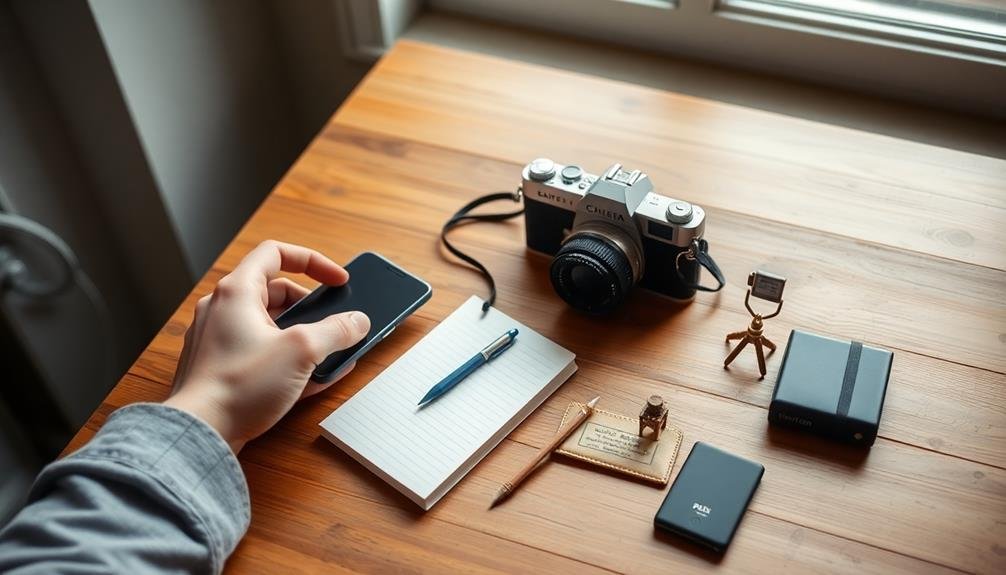
With lighting conditions in mind, let's turn our attention to the elements that will bring your mobile photo story to life.
Preparing props and subjects is essential for creating compelling visual narratives. You'll want to carefully select items that enhance your story's theme and message. Consider the colors, textures, and sizes of your props, ensuring they complement your chosen setting and lighting.
When it comes to subjects, whether they're people, animals, or objects, plan their positioning and interactions in advance. This foresight will help you capture authentic moments and emotions.
Don't forget to:
- Communicate your vision to human subjects, guiding them on wardrobe choices and expected actions
- Prepare any necessary permits or permissions for locations or specific props
- Pack a small kit with essential tools like tape, clips, or fabric for quick adjustments
Scheduling Optimal Shooting Times
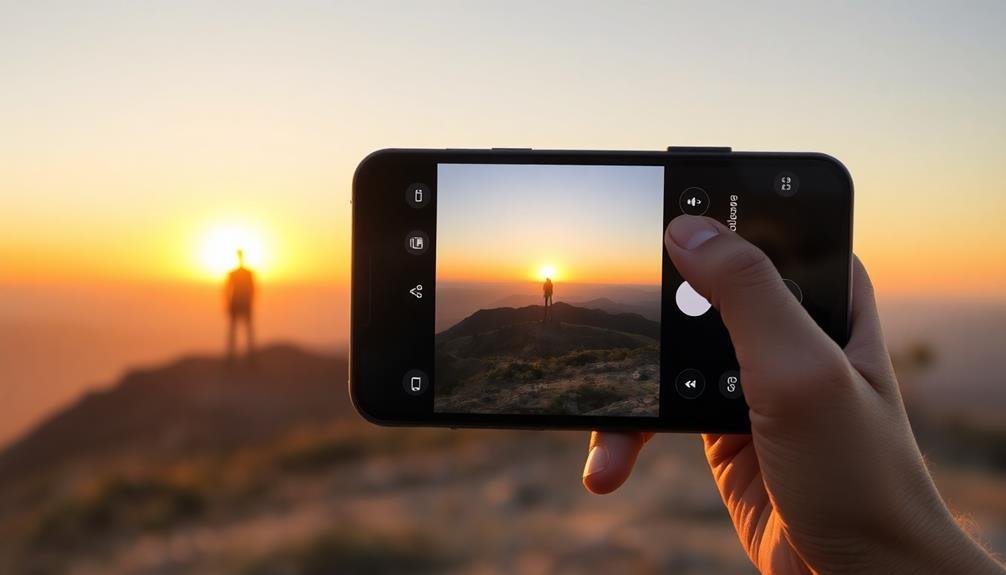
Timing is everything when it comes to scheduling ideal shooting times for your mobile photo story. You'll want to take into account factors like natural light, weather conditions, and the availability of your subjects.
For outdoor shoots, the golden hour—just after sunrise or before sunset—offers soft, warm light that's perfect for capturing stunning images. If you're shooting indoors, plan your sessions during midday when natural light is strongest.
Check the weather forecast and plan accordingly. Overcast days can provide diffused light that's great for portraits, while sunny days are ideal for landscape shots.
Don't forget to account for seasonal changes, as they can dramatically affect lighting and scenery. If you're photographing events or specific locations, research their busiest and quietest times to determine the best moment for your shoot.
Take into account your subjects' schedules and energy levels. For people and pets, morning shoots often yield better results when they're fresh and alert.
If you're capturing cityscapes or night scenes, plan for evening or nighttime shoots. By carefully scheduling your shooting times, you'll maximize the quality of your mobile photo story and create more compelling visual narratives.
Outlining Shot Sequences
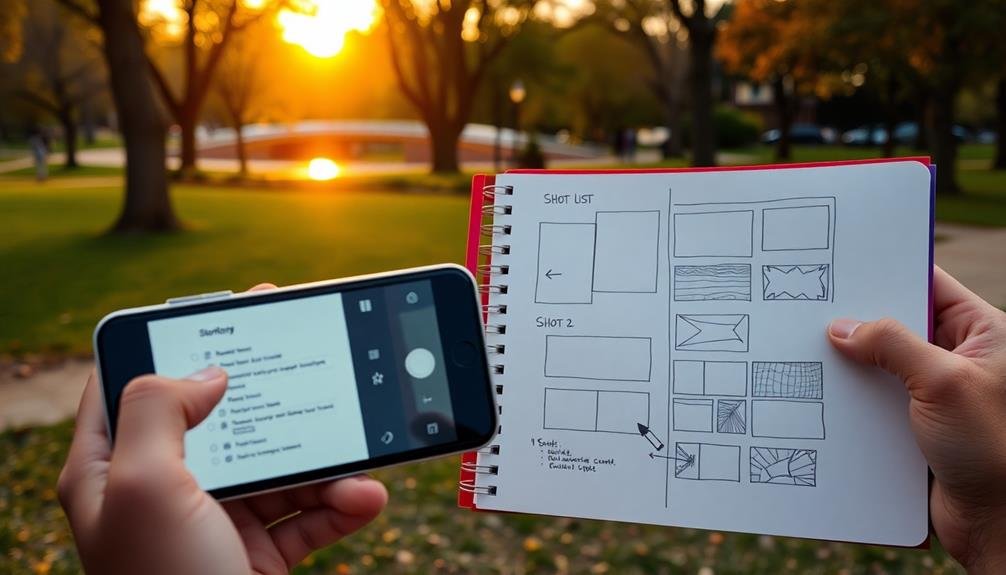
To create a compelling mobile photo story, you'll want to visualize your narrative flow first.
By outlining your shot sequences, you're ensuring coherent shifts between images that tell your story effectively.
Consider optimizing your shooting locations to capture the most impactful shots while maintaining a logical progression through your narrative.
Visualize Narrative Flow
Mapping out your photo story's narrative flow is essential for creating a compelling visual journey. Think of it as charting a course through your story, ensuring each image builds upon the last and leads naturally to the next.
You'll want to contemplate the emotional arc of your narrative, planning how to engage your audience from the opening shot to the final frame.
As you visualize your narrative flow, keep these key elements in mind:
- Pacing: Vary the rhythm of your shots to maintain interest
- Shifts: Plan how you'll move from one scene or idea to the next
- Climax: Identify the peak moment of your story and build towards it
Ensure Coherent Transitions
With your narrative flow visualized, it's time to focus on the connective tissue between your images. Guaranteeing coherent shifts is essential for maintaining your story's momentum and keeping viewers engaged. Start by outlining your shot sequences, considering how each image leads to the next.
Think about visual elements that can link your photos, such as recurring colors, shapes, or themes. Use these connections to create a smooth flow from one image to another. Consider the pacing of your story; mix wide shots with close-ups to add variety and maintain interest.
Don't forget about the emotional journey you're taking your viewers on – each shift should make sense not just visually, but also regarding the feelings it evokes.
Pay attention to the order of your shots. Arrange them logically, whether chronologically or thematically, to guide your audience through the narrative. If you're including text or captions, make sure they complement the visual shifts.
Optimize Shooting Locations
Location scouting is an essential step in crafting your mobile photo story. By optimizing your shooting locations, you'll guarantee that each frame contributes meaningfully to your narrative.
Start by researching potential sites that align with your story's theme and mood. Visit these locations at different times of day to assess lighting conditions and potential challenges.
When planning your shot sequences, consider the following:
- The flow of your narrative: Arrange locations to support a logical progression of your story
- Visual variety: Mix wide shots, close-ups, and detail shots to maintain viewer interest
- Practical considerations: Account for travel time, accessibility, and any necessary permits
As you map out your shooting locations, think about how each setting will impact your story's pacing and emotional arc.
Look for unique angles and perspectives that can add depth to your visuals. Don't forget to plan for connecting shots that'll help link different scenes seamlessly.
Researching Cultural Sensitivities

Before starting on your mobile photo story project, it's crucial to research and understand cultural sensitivities in the areas you'll be photographing. This knowledge will help you avoid unintentional offense and create a more respectful, authentic narrative.
Begin by studying local customs, traditions, and social norms. Pay attention to dress codes, religious practices, and appropriate behavior in public spaces.
Learn about taboos or restricted subjects that might be off-limits for photography. Some cultures may have specific beliefs about capturing images of people, sacred sites, or certain objects.
Familiarize yourself with local laws regarding photography, especially in government buildings or military areas. Research any historical or political conflicts that might influence how your subjects perceive you and your work.
Consider reaching out to local contacts or cultural experts for insights. They can provide valuable information about etiquette, sensitive topics, and appropriate ways to approach potential subjects.
Choosing Appropriate Editing Apps
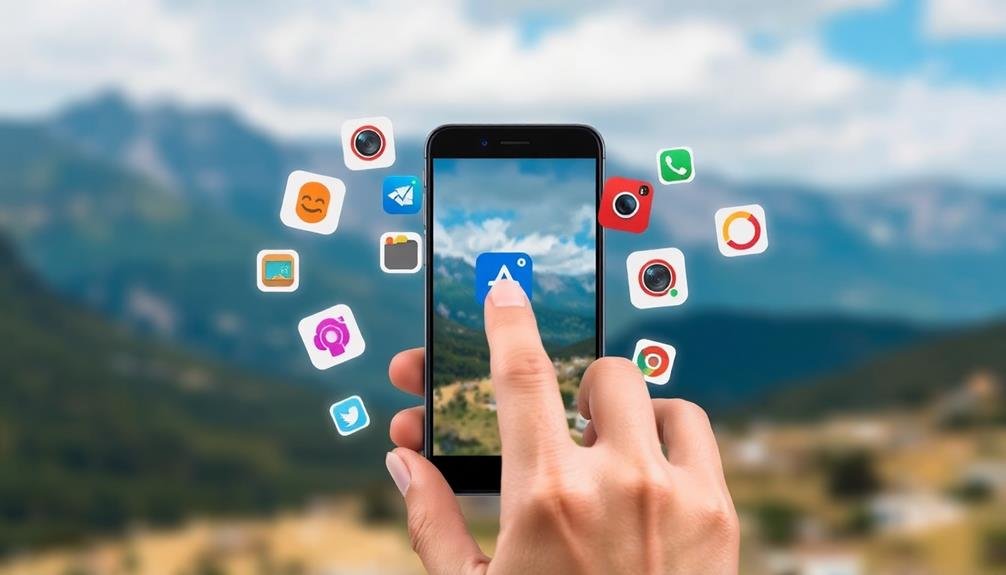
Once you've captured your photos, selecting the right editing apps is crucial for enhancing your mobile photo story. Consider your storytelling goals and the overall aesthetic you want to achieve. Look for apps that offer a range of features, from basic adjustments to advanced editing tools.
When choosing editing apps, prioritize:
- User-friendliness: Opt for apps with intuitive interfaces that won't slow down your workflow.
- Versatility: Select apps that can handle various editing tasks, from color correction to adding text overlays.
- Compatibility: Confirm the apps work well with your device and can export high-quality images.
Don't limit yourself to just one app; combine multiple tools to achieve your desired results. For example, use one app for color grading and another for adding creative effects. Experiment with different apps to find the perfect combination for your storytelling style.
Remember to maintain consistency in your editing choices throughout your photo story. This will help create a cohesive visual narrative that engages your audience.
As you become more familiar with your chosen apps, you'll develop a streamlined editing process that enhances your mobile photo stories efficiently and effectively.
Planning for Technical Limitations
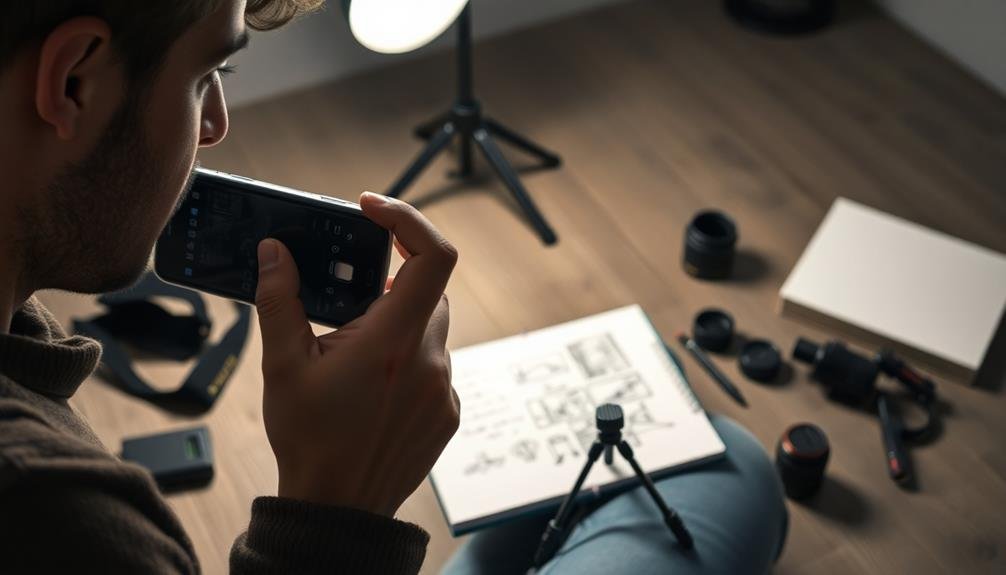
When planning your mobile photo story, you'll need to account for your device's technical limitations.
Consider your smartphone's battery life and plan your shooting schedule accordingly, ensuring you have enough power for the entire session.
You'll also want to manage your storage capacity effectively, perhaps by offloading photos to cloud storage or bringing additional memory cards if your device allows it.
Battery Life Considerations
Battery life is the unsung hero of mobile photography. When planning your mobile photo stories, it's essential to take into account how long your device can last. You don't want to miss that perfect shot because your phone died at the worst possible moment.
To maximize your battery life, consider these strategies:
- Turn off unnecessary features like Wi-Fi, Bluetooth, and GPS when not in use
- Lower your screen brightness or use auto-brightness
- Enable power-saving mode when your battery gets low
Remember, certain activities drain your battery faster than others. Continuous video recording, using flash frequently, and keeping your camera app open for extended periods can quickly deplete your power.
Plan your shooting schedule accordingly, prioritizing the most important shots early in your session.
If you're starting on a long shoot, bring a portable charger or extra battery pack. It's also wise to know where you can find power outlets at your location.
Storage Capacity Management
Just as important as keeping your device powered is ensuring you've got enough space to store all your photos and videos. When planning your mobile photo stories, consider the storage capacity of your device and how it'll impact your ability to capture and save content throughout your adventure.
Start by checking your available storage and estimating how many photos and videos you can realistically take. If you're running low on space, consider offloading older content to cloud storage or an external hard drive before your trip. Many smartphones now offer automatic cloud backups, which can free up local storage as you shoot.
For longer trips or projects, bring portable storage solutions like external SSDs or wireless hard drives. These allow you to transfer files on the go, ensuring you never miss a shot due to a full device.
Additionally, consider shooting in lower resolutions or using file compression to maximize your storage capacity. However, be mindful of image quality trade-offs when doing so.
Crafting a Cohesive Visual Style
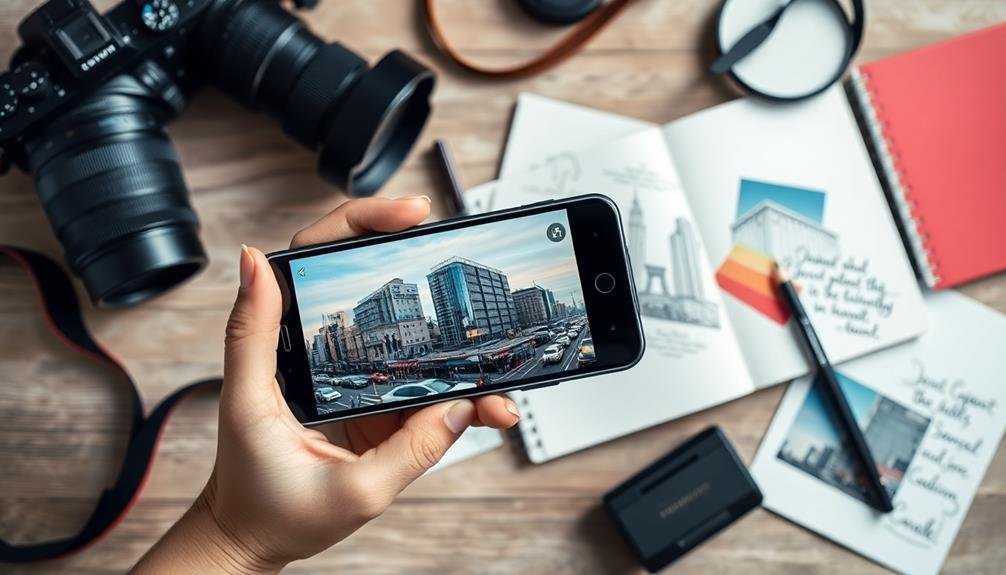
A cohesive visual style is the backbone of any compelling mobile photo story. It's what ties your images together and creates a unified narrative. When planning your photo story, consider the overall aesthetic you want to achieve. This might involve choosing a consistent color palette, deciding on a particular editing style, or selecting a specific aspect ratio for all your shots.
To craft a cohesive visual style, focus on:
- Consistency in lighting: Whether you prefer bright and airy or dark and moody, stick to a similar lighting approach throughout your story.
- Recurring visual elements: Use repetitive shapes, colors, or objects to create a visual thread.
- Consistent framing: Maintain a similar composition style across your images.
You'll want to experiment with different styles before settling on one that best suits your story. Try out various presets or develop your own custom editing process.
Anticipating Potential Challenges
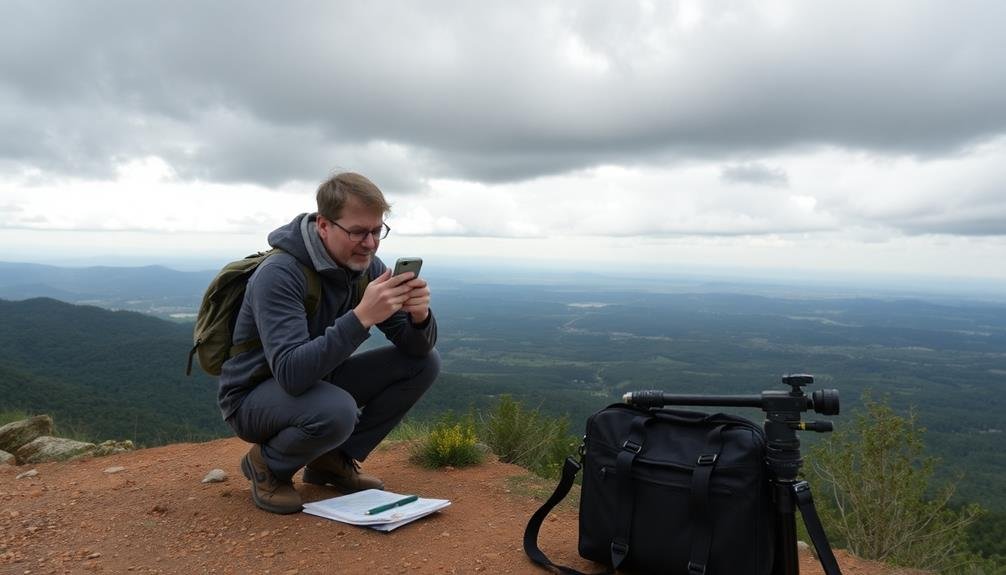
When planning your mobile photo story, you'll need to identify potential obstacles that might hinder your project.
Consider technical issues like battery life, storage capacity, and unexpected weather conditions that could affect your shoot.
Prepare backup solutions, such as carrying spare batteries, external storage devices, and protective gear for your equipment, to guarantee you can overcome these challenges and complete your photo story successfully.
Identify Potential Obstacles
Identifying potential obstacles is vital when planning mobile photo stories. By anticipating challenges, you'll be better prepared to overcome them and guarantee your project's success.
Take into account factors like equipment limitations, location restrictions, and time constraints that might impact your ability to capture the desired shots.
When identifying potential obstacles, focus on:
- Technical issues: Battery life, storage capacity, and device performance
- Environmental factors: Lighting conditions, weather, and accessibility
- Subject-related challenges: Availability, cooperation, and privacy concerns
By addressing these potential roadblocks in advance, you can develop contingency plans and adjust your approach accordingly.
For instance, if you're worried about battery life, bring portable chargers or extra batteries. If lighting conditions are a concern, schedule your shoot during ideal times or bring additional lighting equipment.
Don't forget to take into account legal and ethical obstacles as well. Research location permits, model releases, and copyright issues that may affect your ability to capture and share certain images.
Prepare Backup Solutions
Preparing backup solutions is a key step in mobile photo story planning. You'll want to anticipate potential challenges and have alternatives ready. This guarantees you can still capture your story even if things don't go as planned.
Consider these backup options for common issues:
| Problem | Primary Solution | Backup Solution |
|---|---|---|
| Low battery | Portable charger | Extra phone battery |
| Poor lighting | External light source | Night mode settings |
| Limited storage | Cloud storage | Portable hard drive |
Don't forget to pack essential gear like spare memory cards, lens cleaning cloths, and a waterproof case. It's also wise to have a backup camera or smartphone in case your primary device fails.
Plan alternative shooting locations in case your first choice is unavailable or weather conditions are unfavorable. Research indoor options nearby that align with your story's theme.
Lastly, prepare for potential technical glitches by familiarizing yourself with manual camera settings and basic editing techniques. This way, you can still produce quality content even if your go-to apps or filters aren't working. By preparing backup solutions, you'll be ready to adapt to any situation and keep your mobile photo story on track.
Organizing Equipment and Accessories
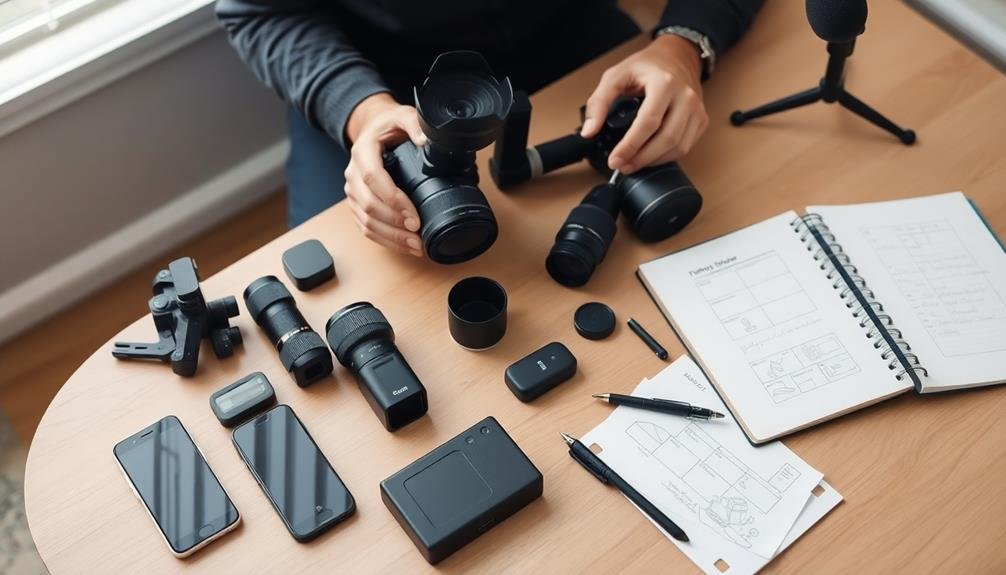
Numerous photographers overlook the importance of organizing their equipment and accessories for mobile photo stories. By planning ahead, you'll guarantee you have everything you need and can access it quickly, allowing you to focus on capturing the perfect shot.
Start by creating a thorough list of all the gear you'll need for your specific project. This might include your smartphone, lenses, tripods, lighting equipment, and any specialized accessories.
Once you've identified your essentials, invest in a quality camera bag or backpack designed for mobile photography. Organize your gear within the bag using:
- Padded dividers to protect delicate equipment
- Small pouches for cables, memory cards, and batteries
- Clear plastic bags for weather-sensitive items
Consider the environment you'll be shooting in and pack accordingly. If you're heading outdoors, include weather protection for your gear. For indoor shoots, pack any necessary lighting equipment.
Always carry spare batteries, power banks, and memory cards. By meticulously organizing your equipment and accessories, you'll be prepared for any situation that arises during your mobile photo story shoot.
Establishing a Shot List
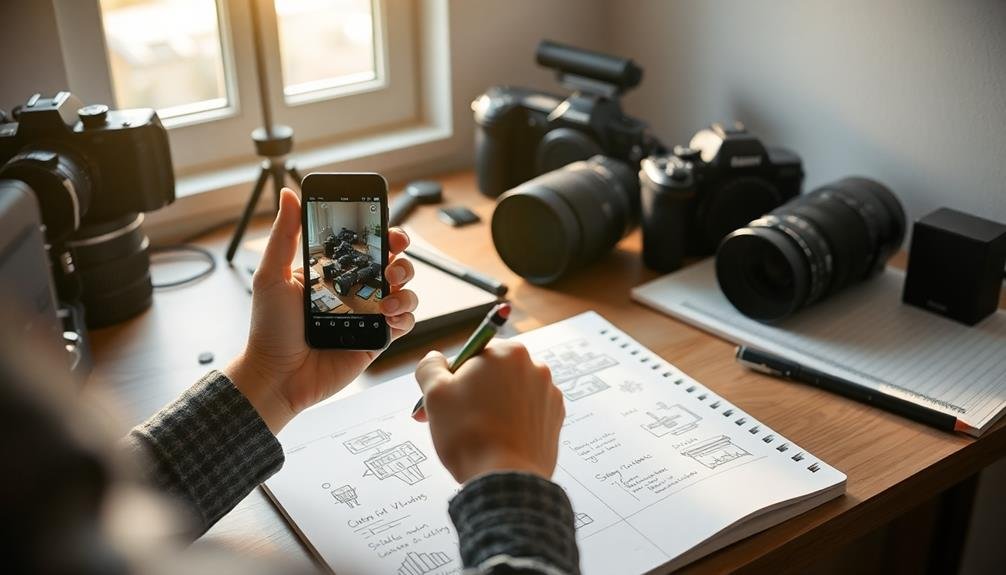
With your gear organized, it's time to focus on the creative aspect of your mobile photo story. Establishing a shot list is vital for capturing all the necessary elements of your narrative. Begin by outlining the key scenes or moments you want to depict. Consider the story's beginning, middle, and end, and identify the shots that will best convey each part.
Think about the variety of shots you'll need: wide-angle establishing shots, close-ups for details, and medium shots for action or interactions. Don't forget to include connections between scenes. As you create your list, consider the technical aspects of each shot, such as lighting conditions and potential challenges.
Prioritize your shots based on importance and logistics. Some locations or subjects may only be available at specific times, so plan accordingly. Include alternate shots or backup ideas in case your original plans fall through.
Frequently Asked Questions
How Can I Maintain Spontaneity While Planning My Mobile Photo Stories?
You can maintain spontaneity by planning your story's general structure but leaving room for unexpected moments. Set themes or goals, but be flexible. Embrace opportunities as they arise, and don't hesitate to deviate from your plan when inspiration strikes.
What's the Best Way to Collaborate With Others on Photo Story Projects?
To collaborate on photo story projects, you'll want to use shared cloud storage, establish clear roles, and set up regular check-ins. Utilize collaborative apps for real-time editing and feedback. Don't forget to communicate openly and respect everyone's creative input.
How Do I Balance Personal Style With Client Expectations in Planned Shoots?
You'll need to strike a balance between your artistic vision and client needs. Communicate openly, show examples of your style, and discuss their expectations. Be flexible, but don't compromise your unique perspective entirely. It's a collaborative process.
Are There Any Legal Considerations When Planning Photo Stories in Public Spaces?
You'll need to contemplate privacy laws, property rights, and permits when shooting in public spaces. Always get consent for identifiable subjects, respect "No Photography" signs, and be aware of restrictions in certain sensitive areas.
How Can I Effectively Use Social Media to Promote My Planned Photo Stories?
You can effectively promote your planned photo stories on social media by consistently posting teasers, using relevant hashtags, engaging with your audience, collaborating with other creators, and sharing behind-the-scenes content. Don't forget to cross-promote across different platforms.
In Summary
You've now got a solid plan for your mobile photo story. By thinking ahead, you'll capture more meaningful shots and create a cohesive narrative. You're prepared for challenges, have your equipment ready, and know exactly what you're aiming to shoot. With this preparation, you'll spend less time fumbling and more time creating. Remember, a well-planned photo story isn't just about individual shots—it's about telling a compelling visual tale that resonates with your audience.





Leave a Reply